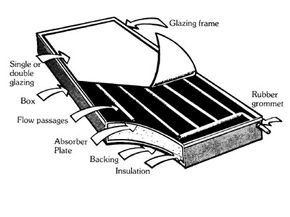Solar Water Heating Systems
The core of a solar water heater is a solar collector and a storage tank. A solar collector is basically a glazed, insulated box with a dark-colored interior and, usually, a bunch of tubes or passageways for water flow. (Glazing is a coat of material, typically glass, that aids in heat retention.) The solar collector turns the sun's radiation into heat. A storage tank is exactly what it sounds like. It holds the water.
That's the basic setup, and some systems aren't much more complicated than that. The first distinction among solar water heaters is cut and dry: passive or active? An active heater uses electrical pumps and controls to move water around the system. A passive heater uses nothing but forces of nature. Passive is the simpler of the two.
Advertisement
There are two primary types of passive systems:
- Batch: This is as uncomplicated as a water heater gets. It's just one or more water tanks inside a solar collector (no tubes in this one). The water warms up right inside the tank, and either gravity or natural convection (the tendency of hot water to rise) moves water from the tank to a home's pipes.
- Thermosiphon: The water tank is separate from the solar collector. Cold water moves through the tubes of a solar collector, and natural convection pumps the resulting hot water into a storage tank. From the storage tank, the water travels into the home's water pipes.
Active systems typically fall into one of three categories:
- Direct: Water moves through the solar collectors and into a storage tank with the help of electrical pumps and controls.
- Indirect: Instead of heating water, the solar collectors heat a "heat transfer" fluid, such as antifreeze. The antifreeze then flows into the sealed piping of a heat exchanger, where it is surrounded by water. The water picks up the heat from the antifreeze (but never mixes with it), and is then pumped into a storage tank.
- Drainback: A drainback system is like the indirect system except that it uses distilled water as the heat-transfer liquid, and it has a separate "drainback" tank for the distilled water. Pumping all of the heat-transfer liquid out of the system and into an interior tank makes it ideal for colder climates, since the liquid isn't exposed to extremely cold weather.
Whether the solar system is passive or active, it costs a lot more than you'd pay for a gas or electric model (more on price later). But some people are cutting back on the cost by making their own. As it turns out, the most basic type, the batch heater, is a relatively simple build-at-home project.
